
So you have to write a white paper…
Got a white paper project on your hands?
But you’re not sure where to begin?
Here’s a quick-start guide that explains all the basics, and points to some handy resources to help you avoid all the most common pitfalls.
Whether you’re brand-new to this field, or you’ve done a few white papers but could use a refresher, this article can help.
This gives you all the best practices that make up the keys to success in writing white papers.
This can be your “White Papers 101” or the definitive guide to writing a white paper.
Note: This article uses the terms “writer” and “client” for the two parties who work most on a white paper.
The writer is most often an outside contractor, but they could be an in-house employee.
The client is most often a marketing person who hires a writer.
But the client could be a product manager or engineer who comes to the marketing team for help doing a white paper. Make sense?
![]()
The three Ps of writing a white paper
To get started, it’s important to understand that a white paper project has three main phases:
- First, you plan your white paper
- Then, you produce the actual document
- Finally, the marketing team promotes the finished white paper
You can think of these as the “three Ps” of any white paper.
Every white paper is a big, complex project with many people involved.
Beginning white paper writers often get a couple of surprises on their first projects.
Surprise #1: Even though we call it “writing a white paper” the writing is only one of a dozen steps along the way.
Few of these steps involve composing or revising text. Most of them involve something else.
Surprise #2: As the writer, it’s up to you to manage the project.
Whether your client tells you or not, they’re pretty much counting on you for that. If you don’t do it, nobody else will.
So let’s take a deeper look at each of the three Ps.
Phase 1: Planning is vital, and doesn’t take long
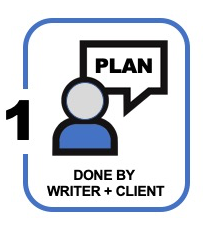 Every white paper should start with a friendly discussion to make sure both the writer and the client are on the same page.
Every white paper should start with a friendly discussion to make sure both the writer and the client are on the same page.
1. First, find the purpose
- Why does the client want to publish a white paper, anyway?
- What is the marketing challenge they’re trying to overcome?
- What are they hoping to achieve for their organization?
- How will they measure success?
Those answers will serve as the compass to guide all your efforts.
2. Next get a fix on the intended audience
If the client’s company has developed any personas to represent their key target markets, get them and study them.
If not, try to explore three key areas about the intended readers:
- Demographics: Facts such as age, education, job title, size of their company, location of their company… anything you can put a number on.
- Psychographics: Attitudes, hopes, dreams, stresses… anything more qualitative than a number. See more on psychographics here.
- Technographics: What device(s) will people use to view the white paper? That could be a desktop, laptop, tablet, smartphone, hard copy on paper, or some combination of the above? (Hint: for 90% of all B2B readers, that will be on a desktop or laptop PC.)
If there are several different segments of the audience, go through this exercise for each one.
But make sure everyone agrees which is the primary audience.
And if your client doesn’t have any precise ideas, a guesstimate can be close enough. For example, if the audience will be a mix of people with all different backgrounds, that’s good to know.
But if the audience will be 80% women in their 30s and 40s, that’s powerful.
And if your client intends to print out a few hundred copies of the white paper for an upcoming trade show, that’s good to know.
That means the page design, big colorful graphics, and pagination will be important.
But if your client expects everyone will simply download the PDF and scroll through it on their screens, the pagination is less important.
And the graphics may need to be smaller and simpler.
There’s no right and wrong here. The goal is simply for everyone to understand who the white paper is aimed at, and who the writer should be trying to reach.
3. Then pinpoint prospects on their customer journey
You must learn where your primary audience is on their customer journey.
- Are they at the start, still exploring the range of possible solutions to a business problem?
- Are they somewhere in the middle where some tips, advice, and encouragement can help them?
- Are they near the end of their journey, ready to compare several competing vendors and choose one to go with?
4. Now you can pick the perfect flavor
 Knowing all this, you can pick the perfect flavor for your white paper.
Knowing all this, you can pick the perfect flavor for your white paper.
You may be familiar with my theory of the three ice cream flavors for white papers:
- Vanilla for a backgrounder, the most traditional and product-oriented type
- Strawberry for a numbered list, the most light-and-lively of all
- Chocolate for a problem/solution, the most complex and long-lasting
For prospects at the start of their journey, the chocolate or problem/solution flavor works best.
This is the classic type of white paper that discusses a nagging business problem and a better way to solve it.
Chocolate is the best flavor for generating leads.
For prospects in the middle of their journey, the strawberry or numbered list flavor works best.
This is a light and lively set of tips, concerns, or questions about a topic that interests your ideal readers.
Strawberry is the best flavor for getting noticed or for throwing dirt on competitors.
For prospects near the end of their journey, the vanilla or product backgrounder works best.
This is a deep dive into the features and benefits of a particular product.
Vanilla is the best flavor for helping a prospect evaluate a product, or to support a new product launch.
Once you pick the right flavor for a white paper, you’ll know what to put in and what to leave out.
For more details, I describe all this in-depth in 100+ pages in my book, White Papers For Dummies.
For a condensed version, you can get my free infographic. Just click on the thumbnail to download the 4-page PDF.
This PDF includes an overall section-by-section guide on what to include in a white paper of each flavor. I often give this a quick glance myself whenever I start a new white paper.
Don’t skip the planning phase
A couple of summers ago, I helped my father-in-law build a shed that was supposed to be pre-fabricated, with all the pieces sawed up and ready to assemble.
Once we sorted through the pile of lumber, we realized there were no plans, no instructions, not even a bill of materials we could use to get started.
We had to go back back to the building store a few times, asking, “You know those pieces that look sort of like this… What are those for?”
Eventually, we put together the shed and it’s still standing proud.
But any kind of plan would have saved us hours of head-scratching and false starts.

So if you skip planning and simply start writing, you’re taking a big risk.
The good news is that planning doesn’t take long. And the more white papers you plan, the faster you’ll get.
For example, to plan out a white paper, I usually need a one-hour phone call with my client, a few hours of web research, and a few minutes to stare off into space and think.
You can do all that inside of a week.
At the end of this phase, the writer can deliver a document several pages long that spells out a high-level plan for the white paper.
Phase 2: Production = creating the white paper
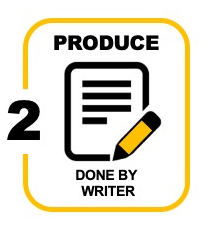 With the planning all done, you’re ready to start creating the white paper.
With the planning all done, you’re ready to start creating the white paper.
This includes all the steps that are easy to imagine:
- Doing research and interviews
- Writing outlines and drafts
- Handling comments from reviewers
- Preparing graphics and designing pages
- Final proofing of the white paper PDFs
- Repurposing into any other formats your client needs
Remember that as the writer, it’s up to you to manage this process and bring everything together into a successful document.
I’ve found that if the writer doesn’t do it, nobody else will.
Researching your white paper
There are really three forms of research involved in writing a white paper:
- Going through background information provided by your client
- Doing independent web research
- Interviewing experts
Let’s consider each type briefly.
1. Going through background provided by your client
How much the writer can rely on background from the client depends in part on which flavor you’re doing.
If you’re writing a vanilla white paper about a product, your client should have lots of background for you.
That material may be slide decks, in-house reports, market studies, press releases, previous blog posts… you name it.
The writer’s job is to sift through all that material and find the key facts and perspectives that will help shape the white paper.
If you’re writing a strawberry white paper, here’s a good way to save time: Schedule a quick session with your client and/or another well-informed employee who they suggest.
Then have some brainstorming to come up with 10 or 12 points, concerns, issues, or questions that can form the heart of your numbered list.
Later you can pare these down to 5 or 7 of the strongest ones. But this initial brainstorming can really save time at the start.
If you’re writing a chocolate white paper about a nagging industry problem, your client will likely have some general market overviews.
But to come up with convincing facts and numbers about the problem, you will most likely have to do a fair amount of web research, as described below.
2. Doing web research

So now you can just jump into Wikipedia, right?
Not so fast.
Whenever I see a white paper that starts by defining some term from Wikipedia, I think, “Amateur night! These people really didn’t do proper research.”
Wikipedia is a great resource, but only if you use it properly.
You can use Wikipedia to get a quick overview of some topic.
But Wikipedia is a secondary source that points to and discusses primary sources.
You can use Wikipedia to find primary sources through the footnotes, and then explore those.
When you quote from primary sources, your evidence has more weight.
Quoting from Wikipedia is a sure sign of lazy and superficial research. So please don’t do it.

As for Google, it’s only as good as your searching skills.
So make sure to keep learning how to search skillfully.
And try out the Advanced Search built into Google. You’ll be amazed what you can do with a few more characters.
And as for evaluating what you dredge up with Google, here are some more tips on reliable sources.
3. Interviewing experts
The client will most often have a few in-house experts who understand the nagging problem, the market space, or the product in great detail.
Those people are often called Subject Matter Experts or SMEs.
The writer’s job is to interview those SMEs and pull the relevant details out of their heads to use in the white paper.
This is where former journalists and technical writers have a head start because they have experience interviewing people.

But if you’ve never interviewed anyone, have no fear. Just prepare a list of topics to delve into or questions you’d like answered.
Then get your SME talking, and record the conversation with their permission so if you miss anything, you can review it later.
Here are some more tips on interviewing experts.
Your interviews will most likely be over the phone, not in person. And you can do a perfectly good interview over the phone.
And here are some tips on recording interviews.
These days, we’re all so used to Zoom that many SMEs will expect to do a Zoom with you. That can work nicely, and you can use Zoom to record the whole conversation as a video.
Video is great for breaking the ice and virtually “meeting” someone.
But if you’re scribbling madly or typing up notes throughout the interview, you don’t want your SME to watch the top of your head bobbing around as you work.
In that case, you may want to turn off your video feed and just use your voice.
Document your sources
Every time I teach a class on white papers, at least one person asks if it’s okay to just make up evidence or quotes.
Of course, I say absolutely not.
Research is hard, slogging work.
And you can easily get distracted and go down a rabbit hole that eats up a couple of hours for an interesting but ultimately useless diversion.
But to create an effective white paper, you have to do it.
And to reassure your client that you did it properly, carefully source and footnote all the facts and quotes in your draft white paper.
I go even further: I submit a complete set of PDFs of sources. That only takes a few minutes. And I believe it sets me apart from other writers.
Most writers provide URLs for their sources. That’s fine until a webpage is moved or taken down. What then?
And really, is a URL enough detail for a footnote?
Most researchers don’t think so. That’s why proper footnotes include a lot more information than just a link.
Write carefully, and then rewrite
White papers are somewhere between marketing and journalism, somewhere between a well-researched journal article and a passionate call for action.
No one can dash off a first draft and think their writing job is complete.
So don’t procrastinate until your back is up against the deadline. Start sooner rather than later and use this method.
You must sleep after writing that first draft. Then rewrite, rethink, polish, and then sleep again. The next day, polish it some more.

Have a trusted partner or writing buddy go through it too.
My wife, Angie, has been my “secret weapon” for two decades now. She’s saved me many times from turning in something with a problem that needed to be fixed.
All this to say, I routinely do five drafts of every section of every white paper before I deliver it.
You must make every word count. Make every word work hard.
A white paper has no room for any lazy thinking or flabby writing. Give your client your very best, every time.
Work closely with the designer
At some point, you hand off your text to a designer to create the graphics and format the pages.
For best results, work closely with them.
Some writers may say, “I’m a word person, not an artist. I’ll leave that to them.”
That’s not the best approach. Not every designer has ever worked on a white paper before.
And they may have some wrong-headed ideas about this type of document.

To help make the white paper a success, tell the designer about the audience you’re trying to reach.
And provide them with:
- Formatting hints typed right into your text file, like “Figure 1 goes here”
- Rough sketches for possible graphics
- Ideas for stock photos, especially for the cover
Talk to the designer about the basic do’s and don’ts of white paper formatting.
If you do, you are helping your white paper to succeed.
And don’t worry about being too pushy. No one likes to work in a vacuum.
In my experience, any truly professional designer will appreciate having a better idea of what you’re trying to achieve with the piece.
Be diplomatic with your client
At several points, your client will review your drafts to give you comments from themselves and their team.
Don’t be grumpy and defensive about their feedback. Every draft from every writer can be improved.
The fact is, most comments won’t hurt a white paper.
To push back on something you see as seriously misguided, refer back to the purpose, audience, and scope you defined in the plan.
Phrase your responses with respect, something like: “I’m concerned that this will take away from the success of this white paper.”
Not: “This is the stupidest idea I ever heard!”

Refocus your client on promotion
You don’t want your client to waste their time micro-managing the writing, illustration, or design of the white paper.
Some clients think this is the fun, creative side of the project. So naturally, they like to be super-involved.
That’s understandable, but you’ve got this.
And they have better things to do, things only they can do (hint: promotion).
If necessary, try to refocus their efforts on their upcoming promotions. Those can be really fun and “creative” as well.
At the end of this phase, you want to deliver a finished white paper your client can post on their website ready to download.
Phase 3: Promotion gets a white paper in front of the right people
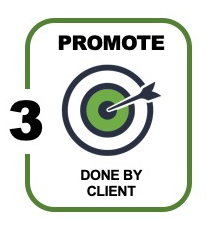 Promotion is often overlooked by clients.
Promotion is often overlooked by clients.
Some clients simply post the white paper to their website, check that item off their To-Do list, and wait for the downloads to start.
Does that sound like enough? Of course not.
In our noisy world, with hundreds of things competing for every prospect’s time and attention, your client needs to make sure your white paper gets noticed.
There are two types of promotions:
- Outbound where you tell prospects about your white paper
- Inbound where you help prospects find it for themselves
Outbound promotions
These tactics are like using a megaphone to blast out your message to your ideal prospects.
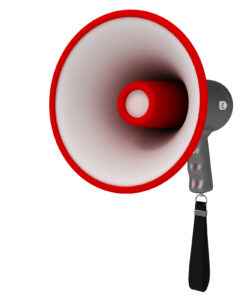
So if your client has a house list of prospects, they should certainly use it to announce the new white paper.
You also want to send your white paper to the inboxes of all these other audiences:
- Your client’s sales force
- Your client’s channel partners
- Any other stakeholders in the company
- Every analyst, journalist, and blogger covering your client’s space
Inbound promotions
These tactics are like using a magnet to attract your ideal prospects.
 You want to help get the white paper noticed by Google, so the search engine results show it to prospects looking for what it covers.
You want to help get the white paper noticed by Google, so the search engine results show it to prospects looking for what it covers.
This is one part planning + one part SEO.
Any white paper that ends up on the first page of Google for your client’s keywords is going to be a success.
Any paper that doesn’t appear until page 5 or 10, not so much.
Must-do promotions
Some promotions are must-do, and some are optional depending on your client’s audience and your budget.
To learn the basic must-do promotions, download a free 18-point checklist you can share with your client.
Conclusions
Well, that’s my guided tour of the three phases of any white paper, with lots of tips and supporting articles to look at for each phase.
I hope that was helpful. And I wish you great good fortune doing your next white paper!

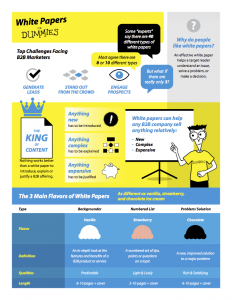




What a tremendously helpful explanation of the White Paper process. Thanks for breaking it down into logical steps and providing lots of supporting articles to flesh out the details. I guess that’s why you’re The White Paper Guy! I’m looking forward to meeting you next month in Delray Beach. Cheers!
Wow! Some great information, especially for a beginner like me. These points were explained quite clearly, and I’ll keep it nearby to refer to it again & again.
I really enjoyed reading this post. I clicked over on the link about sourcing your sources. And that article was great too! This was great information as I prepare to do my first couple of white papers. I already purchased the book! So this makes me more excited to receive it!